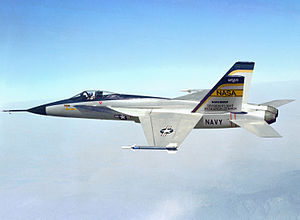Northrop P-530
| YF-17 "Cobra" | |
|---|---|
 |
|
| YF-17 in 1976 during a demonstration flight | |
| Role | Prototype fighter aircraft |
| Manufacturer | Northrop |
| First flight | 9 June 1974 |
| Status | Retired |
| Primary user | United States Air Force (intended) |
| Number built | 2 |
| Developed into | McDonnell Douglas F/A-18 Hornet |
The Northrop YF-17 (nicknamed "Cobra") was a prototype lightweight fighter aircraft designed for the United States Air Force's Lightweight Fighter (LWF) technology evaluation program. The LWF was initiated because many in the fighter community believed that aircraft like the F-15 Eagle were too large and expensive for many combat roles. The YF-17 was the culmination of a long line of Northrop designs, beginning with the N-102 Fang in 1956, continuing through the F-5 family.
Although it lost the LWF competition to the F-16 Fighting Falcon, the YF-17 was selected for the new Naval Fighter Attack Experimental (VFAX) program. In enlarged form, the F/A-18 Hornet was adopted by the United States Navy and United States Marine Corps to replace the A-7 Corsair II and F-4 Phantom II, complementing the more expensive F-14 Tomcat. This design, conceived as a small and lightweight fighter, was scaled up to the Boeing F/A-18E/F Super Hornet, which is similar in size to the original F-15.
The aircraft's main design elements date to early 1965, from the internal Northrop project N-300. The N-300 was itself derived from the F-5E, and features a longer fuselage, small leading-edge root extensions (LERX), and more powerful GE15-J1A1 turbojets, rated at 9,000 lbf (40 kN) each. The wing was slightly elevated to increase ordnance flexibility. The N-300 further evolved into the P-530 Cobra, which uses 13,000 lbf (58 kN) GE15-J1A5 engines, with a very small .25 bypass ratio leading to the nickname "leaky turbojet". The bypass effectively was only a cooling stream for the rear of the engine, allowing the engine bay to be constructed of lighter, cheaper materials.
...
Wikipedia
